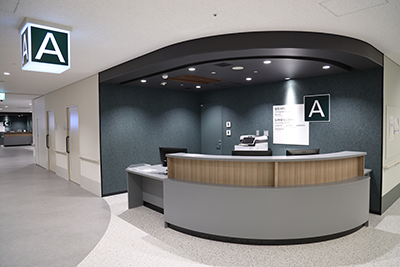Neurosurgery
Introduction

The neurosurgery department at our hospital uses reliable technology and diagnostic capabilities to provide safe and state-of-the-art treatments to provide medical care that patients and their families can trust, and strives to satisfy them.
Characteristics of this department
Iseikai International General Hospital is certified as a Primary Stroke Center and performs mechanical thrombectomy in addition to rt-PA intravenous therapy.
The neurosurgery department performs 320 surgeries per year, and in addition to cerebrovascular surgery, it also treats benign and malignant brain tumors, trauma, hydrocephalus, facial spasms, trigeminal neuralgia, and more.


Main diseases
Brain tumors
- Gliomas
- Anaplastic gliomas
- Glioblastomas
- Meningiomas
- Neurilemomas
- Pituitary adenomas
- Metastatic brain tumors
Cerebral vascular disorders
- Cerebral hemorrhage
- Cerebral infarction (cardiogenic cerebral embolism, atherothrombotic cerebral infarction, lacunar infarction)
- Moyamoya disease
- Carotid artery stenosis, subclavian artery stenosis
- Cerebral aneurysm
- Subarachnoid hemorrhage
- Cerebral arteriovenous malformation
Head trauma
- Acute subdural hematoma
- Acute epidural hematoma
- Cerebral contusion
- Traumatic subarachnoid hemorrhage
- Skull fractures (nasal bone fractures and orbital floor fractures are handled by our plastic surgery department.)
Functional diseases
- Normal pressure hydrocephalus
- Facial spasms
- Trigeminal neuralgia
Operative surgeries
We have doctors who are skilled in both craniotomy and intravascular catheter surgery, and we strive to provide minimally invasive treatments based on team medical care. Even in craniotomy, we strive to perform minimally invasive surgeries by using navigation and fluorescent evoked electromyography with ICG and 5ALA.
Craniotomy
- Cranial tumor removal (including extensive skull base surgery)
- Endoscopic pituitary tumor removal
- Cranial clipping
- Cranial hematoma removal
- Endoscopic hematoma removal
- Microvascular decompression for facial spasms and trigeminal neuralgia
- External decompression
Catheterization
- Coil embolization for cerebral aneurysms
- Stent placement for carotid artery stenosis and subclavian artery stenosis
- Percutaneous cerebral thrombectomy
- Percutaneous cerebral angioplasty for intracranial vascular stenosis
- Tumor embolization for brain tumors
Other
- Hydrocephalus surgery (VP shunt, LP shunt, endoscopic third ventricle floor fenestration)
- Chronic subdural hematoma burr hole irrigation
- Ventricular drainage
Outpatient schedule
Morning 9:00~12:00(Reception8:00-11:30)/
Afternoon to Evening 13:30~16:30(Reception13:00-16:00)
| Mon | Tue | Wed | Thurs | Fri | |
|---|---|---|---|---|---|
| Morning | ● | ● | ● | ● | ● |
| Afternoon to Evening | - | - | - | - | - |
Medical track record of the clinical department
- Number of cases by procedure
- Number of cases by anesthesia method
- Number of extracranial catheter surgeries
-
Surgical method Number of procedures Chronic subdural hematoma drilling and irrigation 49 Intracranial hematoma removal 26 Skull bone formation 10 Intracranial tumor removal 7 Cerebral aneurysm neck clipping 6 Endoscopic intracranial hematoma removal 5 Burner hole ventricular drainage 5 Hydrocephalus surgery 5 Endoscopic transnasal tumor removal 2 Arterioplasty, anastomosis 2 Spinal fixation, laminectomy, laminectomy 2 Decompressive craniotomy 2 Intracranial tumor removal 2 Brain abscess drainage 1 Total brain abscess removal 1 Arterial thrombus endarterectomy 1 Skull tumor removal 1 Cerebral fluid shunt removal 1 Intracranial mass removal 1 Total number of medical departments 129 -
Anesthesia method Number of cases General anesthesia 75 Local anesthesia 54 Conduction anesthesia (nerve block) 3 Total number of medical departments 132 -
Surgical method Number of cases Percutaneous cerebral thrombectomy 23 Percutaneous carotid artery stent placement 10 Percutaneous cerebral angioplasty 4 Coil embolization 2 Total number of medical departments 39
Academically certified facility
- Japan Neurosurgical Society Specialist Training Program Training Facility
[Japan Neurosurgical Society https://jns-official.jp/residents/training_program] - Japan Stroke Society Primary Stroke Center (PSC) Core Facility
[Japan Stroke Society/Stroke Center Certification Committee https://www.jsts.gr.jp/facility/psccore/] - Japan Stroke Society Certified Training and Education Hospital
[Japan Stroke Society https://www.jsts.gr.jp/facility/]
Regarding clinical research
Click here for more information on clinical research

